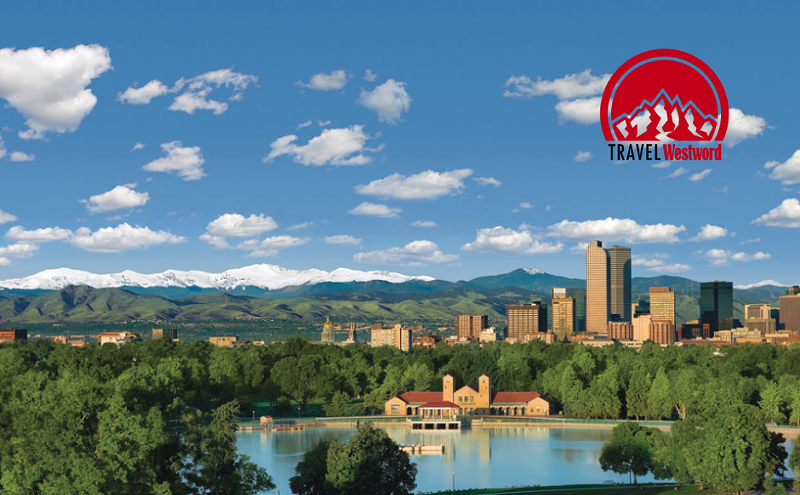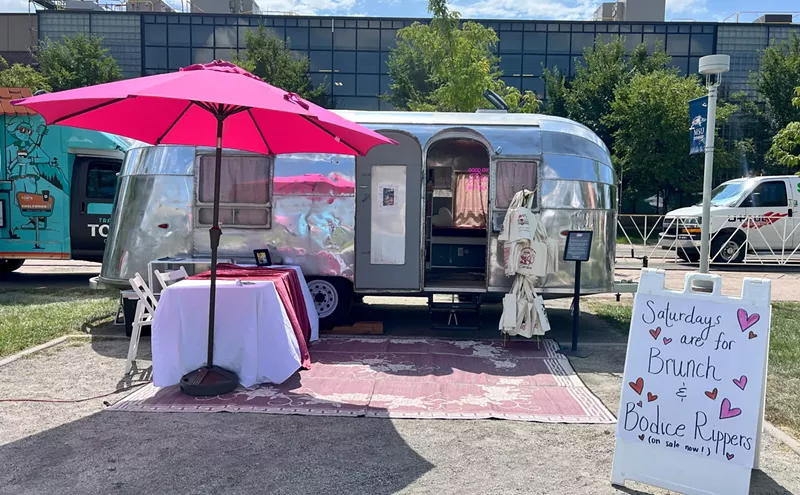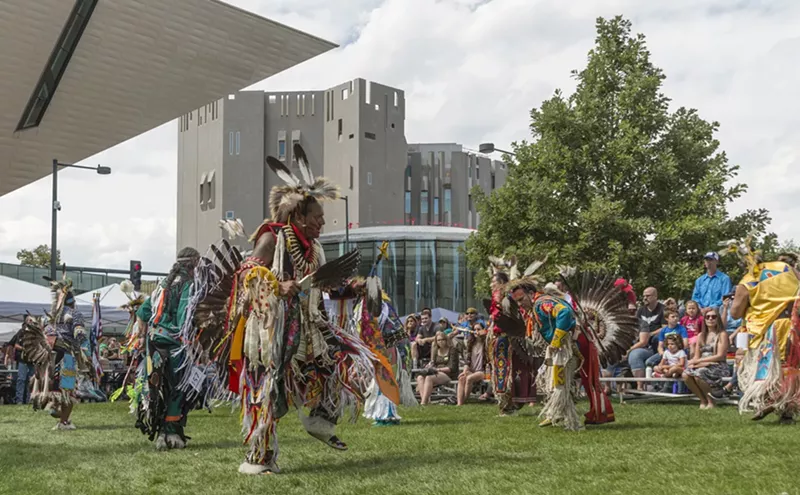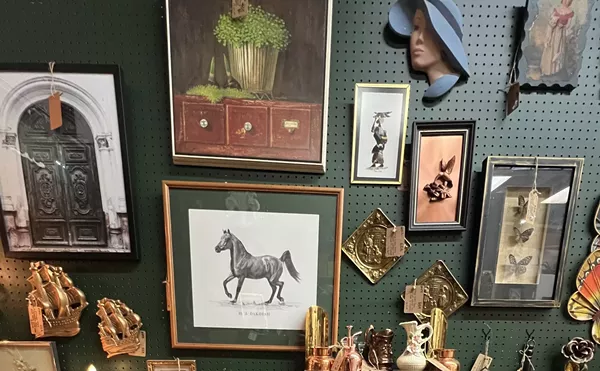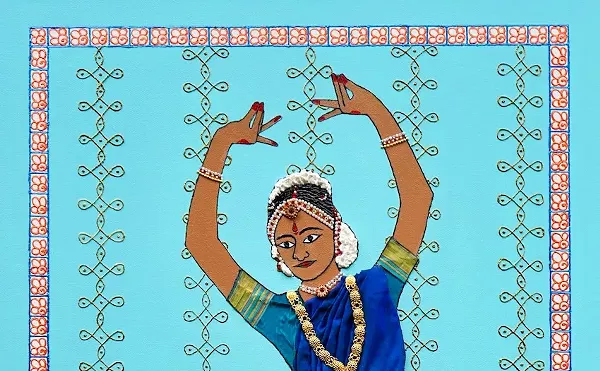It is a testament to the adaptability of the individual that my brain didn’t explode last week when circumstances put my aesthetic judgment in a kind of netherworld. That’s because at the same time that I was putting together my guide to the worst of the new architecture in Denver, I found myself in the presence of its total opposite: a bona fide architectural triumph. And as I walked up the front steps of the stunning Colorado Springs Fine Arts Center, I couldn’t help but think that this was exactly what I needed to see after having just witnessed so many horrors.
Completed in 1936, the CSFAC has a style that refers simultaneously to the nascent modernism of that time and to the pueblos of the Southwest. The work of John Gaw Meem, with a hyper-sensitive addition by David Tryba, the building is not just a notable landmark; it’s also where a big chunk of Colorado’s art history happened during the middle third of the twentieth century. Since taking the reins of the CSFAC’s museum in 2007, Blake Milteer has delved into that art history with a series of exhibitions devoted to center-associated artists including Birger Sandzén, Charles Bunnell and Ellen O’Brien, among others. The current offering, FAC Legacy Series: Frank Mechau, will be the last for Milteer; he’s moving to Scotland this summer to join his wife. Joy Armstrong, who already works as a curator at the CSFAC, will take over.
Mechau was associated with the Broadmoor Academy and its successor, the CSFAC, in the 1930s, when he himself was in his thirties. He had just returned from three years in Paris, a period during which he became aware of the rise of abstraction and also made trips to Italy to study frescoes by the likes of Piero della Francesco and Giotto. Though Mechau wasn’t born in Colorado, his family had moved here when he was only three, so it was his home, and it’s where he returned in 1932. The exhibit includes work he did in Paris, and some of it, like “Abstraction Méchanique,” a very Dalí-esque composition, is quite radical for the time. Still, the show really takes off with pieces that Mechau exhibited once he was back in Colorado. “Football Abstraction,” created the year he returned, is somewhat surrealistic and contains what would become a signature Mechau move: a clear distinction between figure and ground, so that the abstract football players stand out from the background, occupying their own space right at the picture plane, with the field receding behind them.
Mechau started teaching at the Broadmoor Academy in 1934 and received a commission to create a mural for the CSFAC’s new building that opened in 1936. “Wild Horses” is his best-known piece, a sixty-foot-long fresco that still adorns an exterior wall facing the courtyard. It’s not in the show, of course, since it’s permanently affixed to the wall — but you should definitely take time to see it. It’s spectacular, comprising more than twenty simplified depictions of running horses within a relatively narrow horizontal band that runs above visitors’ heads. In this mural, as in the football painting, Mechau reveals his interest in rendering subjects in motion. But “Wild Horses” also indicates that the artist was increasingly embracing the romantic lore of the American West, presenting it in an updated modernist way that he’d first explored while in Paris. Western themes dominated the work he did over the rest of his very short career (he died in 1946, at the age of 42), and the show has a number of these spectacular pieces — in particular, the murals “Indian Fight” and “Wild Horse Race” — and the studies for them, including “Bar Room Brawl.”
In the enormous gallery adjacent to the two dedicated to the Mechau solo, Milteer reveals another of his longtime penchants: showcasing contemporary Colorado artists. When I asked who curated Gary Emrich: Promise, he smiled and told me it was Emrich, meaning that although Milteer booked the show, he let the artist take the lead in selecting the work. Emrich is a noted Denver artist who has set himself apart with videos — he’s a local pioneer in the medium — and photo-based digital works. Interestingly, two of the five types of work included here — the two that throw the strongest visual punches — are those that encapsulate the idea of exploration: in the West, reflecting Mechau’s interest, and of space, since Colorado is a center for aerospace technology.
Those Western-themed pieces are from Emrich’s “Firewater” series and have a post-pop sensibility, thanks to both his subject and the way he puts the pieces together. Emrich has found figural liquor decanters with stereotypically rendered depictions of an array of Old West characters, such as a cowboy, a prospector, a marshal and so on. These decanters have a sickly-sweet quality, like the kitsch figurines that they are meant to ape. Emrich has placed them in little dioramas — the backgrounds are blow-ups of mountain landscapes appropriated from various water-bottle labels that depict idealized scenery — and then taken digital photos of the staged scenarios. These smart pieces represent a great contemporary take on the Western tradition; they are also visually impressive, both individually and when you see all ten lined up on the long wall opposite the gallery’s main entrance.
In a section walled off from the main gallery, Emrich has installed “Contact,” a two-channel video linking nature with space that he debuted a few years ago at the Denver Art Museum. A large projection of bees landing on flowers has been paired with a circular screen on which a film of a moon shot through a telescope is projected. Emrich likens the way the bees approach the flower to the way the astronauts approach the moon; it’s very hypnotic. Another revelation are a group of pseudo-abstracts from Emrich’s “All Consumed” series, in which he has taken photos through water-filled blister packs of disassembled packaging. The results appear to be digitally manipulated, but they’re actually straight photos.
In order to access either the Mechau or Emrich show, you’ll need to go through the wide corridor spaces that have been given over to works from the CSFAC’s permanent collection. It’s here that you’ll find nearly all of the Walt Kuhn paintings owned by the CSFAC — more than forty of them. This is a rare opportunity to see all but two pieces from Kuhn’s remarkable “Imaginary History of the West” oil sketches, which are extremely advanced for the years they were created (1918 to 1920).
You have almost a month left to catch Mechau and Emrich (a little less for Kuhn), Colorado artists significant in their own way and for their own time. The shows are good on their own, but the truly magnificent building that houses them makes this a can’t-miss trip.
Frank Mechau and Gary Emrich, through May 15 at the Colorado Springs Fine Arts Center, 30 West Dale Street, Colorado Springs, 719-634-5581, csfineartscenter.org.

Audio By Carbonatix
[
{
"name": "GPT - Billboard - Slot Inline - Content - Labeled - No Desktop",
"component": "23668565",
"insertPoint": "2",
"requiredCountToDisplay": "2"
},{
"name": "STN Player - Float - Mobile Only ",
"component": "23853568",
"insertPoint": "2",
"requiredCountToDisplay": "2"
},{
"name": "Editor Picks",
"component": "17242653",
"insertPoint": "4",
"requiredCountToDisplay": "1"
},{
"name": "Inline Links",
"component": "18838239",
"insertPoint": "8th",
"startingPoint": 8,
"requiredCountToDisplay": "7",
"maxInsertions": 25
},{
"name": "GPT - 2x Rectangles Desktop, Tower on Mobile - Labeled",
"component": "24956856",
"insertPoint": "8th",
"startingPoint": 8,
"requiredCountToDisplay": "7",
"maxInsertions": 25
},{
"name": "Inline Links",
"component": "18838239",
"insertPoint": "8th",
"startingPoint": 12,
"requiredCountToDisplay": "11",
"maxInsertions": 25
},{
"name": "GPT - Leaderboard to Tower - Slot Auto-select - Labeled",
"component": "17676724",
"insertPoint": "8th",
"startingPoint": 12,
"requiredCountToDisplay": "11",
"maxInsertions": 25
}
]

